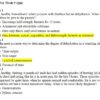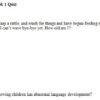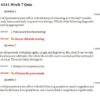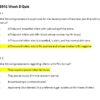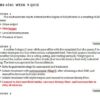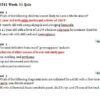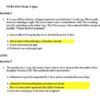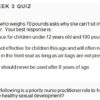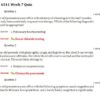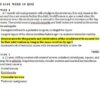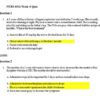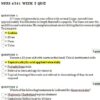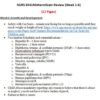Description
NURS 6541N Final Exam – Question and Answers – Primary Care Adolescent & Child Spring Term
- Antibiotic therapy is one of the mainstays of treatment for which of the following causes of wheezing?
- Dave, age 17, has gynecomastia. You should also assess him for
- A small-for-gestational-age infant is born to a 35-year-old woman. He has low-set and malformed ears, microcephaly, rocker-bottom feet, inguinal hernias, cleft lip/palate, and micrognathia. Chromosomal analysis is likely to reveal which of the following?
- Primary dysmenorrhea is due to
- A 3-week-old male infant with 2 days of the projectile, non bilious vomiting and constant feeding. Which of the following is the most likely etiology?
- Which of the following foods would be most appropriate for a child with celiac disease?
- Which of the following is a measure of childhood intelligence?
- An 8-month-old baby arrives to the office with his mother with a complaint of decreased left arm movement. He is a product of a normal-term pregnancy, has had no medical problems, and was in good health when his mother dropped him off at the daycare center. Upper arm radiographs show a left humerus spiral fracture. Which of the following is the most appropriate next step in management?
- A 4-year-old female with profuse vomiting, sweating, lacrimation, and diarrhea, who seizes in the emergency room. Which of the following is the most likely etiology?
- A 9-year-old is diagnosed with dyspepsia without hematemesis, melena, or occult blood. The most appropriate next step is
- Which of the following therapeutic options is common for the treatment of both bees sting and bite wounds?
- You are examining Beth, age 9 months, and note a palpable right supraclavicular node. You know that this finding is suspicious for
- When examining a child with abdominal pain, what symptom would lead to a likely organic etiology?
- Which of the following objective data are associated with significantly better long-term outcomes in children born with open spina bifida?
- A 14-year-old has a 3-week history of fever, anorexia, and abdominal pain. What additional symptoms would cause the NP to suspect Crohn’s disease?
- A 3-year-old presents with microcephaly, developmental delay, coarse facial features, large tongue, kyphosis, hip dislocation, tonsillar and adenoidal hypertrophy, and hepatomegaly. She is receiving early intervention services without improvement. What is the best next step?
- Ben has been diagnosed with folliculitis, an inflammatory condition involving the pilosebaceous follicle. What is the most common cause of this condition?
- Which of the following is not true of insect stings from bees, wasps, and fire ants?
- Unilateral wheezing is a finding suggestive of
- A 16-year-old is brought in as a walk-in by his parents. His parents state that he acutely developed a fever, chills and rash. He has been confused and not answering their questions. On examination, he is toxically ill-appearing and is febrile, tachycardic and hypotensive. He is noted to have a diffuse petechial rash. What is the most likely diagnosis?
- A 12-year-old girl was brought to the emergency department because of a severe sore throat, muffled voice, drooling, and fatigue. She had been sick for the past 3 days and is unable to eat because of painful swallowing. The parents deny any history of recurrent pharyngitis. The patient still managed to open her mouth and you were able to see an abscess at the upper pole of the right tonsil with a deviation of the uvula toward the midline. The examination of the neck reveals enlarged and tender lymph nodes.
- Which of the following is the most appropriate management?
- A 15-day-old infant has respiratory distress. A quick observation suggests she has slight cyanosis, hepatosplenomegaly, and features consistent with Down Syndrome. The cardiac examination demonstrates a loud first heart sound, a low-pitched, mid-diastolic murmur at the lower left sternal border, and a harsh apical holosystolic murmur in the mitral area. Which of the following cardiac conditions most likely explains her heart findings?
- The organism that causes hand, foot, mouth syndrome is what virus?
- Your patient has inflammatory bowel disease. Which of the following finding is most consistent with ulcerative colitis?
- Jesse, age 5, has a diagnosis of encopresis. After the diagnosis, what would be your next action?
- The parents of an 8-year-old Down Syndrome boy arrive for his annual well-child visit. He wants to participate in sports, including the Special Olympics. Until further examination can be completed, which of the following sports would you suggest as being safe?
- Six months after being diagnosed with what appears to be insulin-dependent diabetes, the 5-year-old in the case presentation has a significant decrease in his insulin requirement. Which of the following is the most likely explanation?
- The classic radiographic finding of croup is
- A common cause of in-toeing in childhood is
- Mrs. Bay is upset. She is convinced something is seriously wrong with her son. He is a 2-month-old and frequently vomits after feeding. Which of the following is most suggestive of GERD (gastroesophageal reflux disease)?
- Which of the following is true regarding the diagnosis of epiglottitis?
- Of the following patients, which child should not receive a tuberculin skin test?
- Hope is a 7-month-old who presents in January with a 1-day history of cough, yellow nasal discharge, and low-grade temp (T max 100°F). She was previously healthy. She does have 2+ edema of the nasal turbinates and cloudy rhinorrhea. She-is afebrile in the office. Her chest, mouth, and ears are clear. You prescribe:
- An ex-preemie with bronchopulmonary dysplasia has been discharged to home from the NICU. One potential problem area that requires close monitoring is
- Which of the following symptoms are most suggestive of pneumonia in a young child?
- A 14-month-old child has lower extremity bowing, a waddling gait, genu varum, and is at the 5th percentile for height. Laboratory data include low-normal serum calcium, moderately low serum phosphate, and elevated serum alkaline phosphatase levels, hyperphosphaturia, and normal parathyroid levels. Which of the following is the most likely diagnosis?
- Lisa has Cushing’s syndrome. You would suspect her to have or to develop
- You have a patient that you think may have intussusception. Which of the following finding may you see?
- An 11-month-old male with intermittent bouts of crying and non bilious vomiting has a history of Meckel diverticulum. A small elongated mass is felt on the right side of his abdomen. Which of the following is the most likely etiology?
- Tracy, the mother of a 2-year-old, is concerned because her daughter walks on her toes all the time. What do you tell her?
- Mark, age 15, is 5 feet tall and weighs 85 pounds. You suspect anorexia and know that the best initial approach is to
- The following clinical description best matches which genetic disorder? A tall, thin 14-year-old boy has no signs of puberty. He was delayed in his speech development and always has done less well in school than his siblings. He is shy, and teachers report his activity is immature. Physical examination reveals breast development and long limbs with a decreased upper segment/lower segment ratio. He has small testes and phallus.
- Which test is routinely recommended for a preparticipation sports physical?
- Prophylactic penicillin should be started in children with sickle cell anemia by
- Which of the following statements is not true with slipped capital femoral epiphysis?
- Fifth disease is usually
- A head injury in which bruising or tearing of the cerebral structures occurs is a
- Sam is a healthy 17-year-old student. He is thinking about having sex and asks for more information about condoms. You give him all of the following information except
- A 15-year-old girl has experienced abdominal pain, vomiting, and lethargy for 3 days.
- Her chest and throat examinations are clear, but her abdominal examination is significant for right lower quadrant pain. Rectal examination is equivocal for pain, and her pelvic examination is remarkable for pain upon movement of her cervix. Laboratory data include elevated white blood cell count, a serum glucose level of 145 mg/dL, and a serum bicarbonate level of 21mEq/dL. Her urinalysis is remarkable for 1+ white blood cells, 1+ glucose, and 1+ ketones. Which of the following is the most likely diagnosis?
- A common presenting symptom of inflammatory bowel disease is
- Tommy has bloody diarrhea. His family eats fast-food four to five times each week. Which organism may have caused diarrhea?
- While doing a 5-year-old well-child exam, you notice two small patches of hair loss. Broken hair is present, as is erythema and scaling. On the basis of this information, which of these is the likely diagnosis?
- A 14-year-old girl from another state was followed for 7 years for a history of insulin-dependent diabetes mellitus. Her hemoglobin A1C is 14.9%. This laboratory test indicates which of the following?
- A 6-year-old boy is left alone for 10 hours, now with hematemesis and pneumomediastinum on chest x-ray. Which of the following is the most likely etiology?
- The following clinical description best matches which genetic disorder? An institutionalized male juvenile delinquent upon close examination has severe nodulocystic acne, mild pectus excavatum, large teeth, prominent glabella, and relatively long face and fingers. His family says he has poor fine motor skills (such as penmanship), an explosive temper, and a low-normal IQ.
- Riley, a 12-year-old girl, has scaly, hyperpigmented lesions in a “Christmas tree” distribution.
- It is predominantly on her trunk. One lesion is on her buttock that is larger than the other, at about 4 cm in diameter. What is your diagnosis?
- A healthy, thriving 4-year-old male has had sudden episodes of drawing his knees to his chest and crying like he is in acute pain for the last 5 hours. These episodes are separated by quiet times when he appears normal and comfortable. He is not vomiting and has not had a bowel movement today. What is the most likely diagnosis?
- In children who have not received antibiotics in the past month, which antibiotic is recommended by the Centers for Disease Control and Prevention for the management of acute bacterial respiratory infection?
- Which of the following is not a feature of DiGeorge syndrome?
- What is the appropriate management of a child with asthma who presents with acute wheezing and/or coughing?
- Jennifer, age 16, is an active cheerleader who just developed type 1 diabetes. She is worried that she will not fit in with her friends anymore because she does not think she can have all the same snacks they have. How do you respond?
- Shelby is a healthy 4-week-old who presents to your office in mid-January with a 3-day history of nasal congestion with occasional cough. She started running a low-grade fever last night (T max 101.5°F). Now she is refusing to nurse and has paroxysmal coughing and noisy/labored breathing. Physical exam reveals an ill-appearing infant with lethargy and tachypnea, intercostal retractions, expiratory wheezes, and occasional rales.
- She does not attend daycare but has a 3-year-old sibling who does and who recently had a “cold.” What is the MOST LIKELY cause of Shelby’s illness?
- The diet of a 3-year-old with cystic fibrosis should be supplemented with which of the following?
- Which of the following vaccines provides protection against a common type of sepsis/meningitis?
- You are seeing a patient you think may have IBD. Which of the following tests would not be helpful?
- Sarah, age 13, is markedly obese and has a poor self-image. How do you differentiate between compulsive eating and bulemia?
- Which of the following is not associated with congenital adrenal hyperplasia?
- Which of the following is not a sign or symptom of congenital hypothyroidism?
- A 2-year-old girl has increased work of breathing. Her father notes she had cough and subjective fever over the past 3 days. She has been complaining that her “belly hurts” and has experienced one episode of post-tussive emesis but no diarrhea. Her immunizations are current, and she is otherwise healthy. Her temperature is 102°F. She is somnolent but easily aroused. Respirations are 28 breaths/min, and her examination is remarkable for decreased breath sounds at the left base posteriorly with prominent crackles.
- Which of the following acute interventions is the LEAST likely to assist in the diagnosis?
- During a track and field meet, a 16-year-old male pole-vaulter falls to the ground screaming in pain. He complains of intense pain in his right scrotum. He vomits twice while waiting for the ambulance. He most likely has
- A 5-year-old girl is somewhat short and has mild leg bowing. Her medical history is significant only for a well-controlled seizure disorder. Serum calcium, phosphorus, and alkaline phosphatase levels and urinary amino acid concentration are normal. A bone age is notable for abnormal distal radius and ulna mineralization. Which of the following is the most likely diagnosis?
- Screening infants for anemia should occur at what age?
- When Jason, age 12, slid into homeplate while playing baseball, he injured his ankle. You are trying to differentiate between a strain and a sprain. You know that a sprain
- Which of the following is not found in an adolescent with untreated Graves’ disease?
- A 10-year-old male presents with a fever of 102ºF and complaints of leg pains. His mother reports that he had an upper respiratory infecion with a sore throat about 2 weeks ago. No treatment was needed. On examination, he has tender and swollen knees bilaterally. His heart rate is 125 bpm and a blowing systolic murmur is heard at the apex. No murmur was noted at in the chart. The mostly diagnosis is:
- The most common congenital heart defect in children as
- You are on call and receive a phone call from the parents of a 13-year-old known asthmatic. She has been having chest tightness and a worsening cough for 48 hours. She has a significant nasal discharge that began 14 days ago and intermittent complaint of headache. She is now running a low-grade fever. Her peak flow the last 48 hours is 70–80% of her personal best. Her temperature right now is 101.7°F. She is on salmeterol with corticosteroid (Advair) and PRN albuterol. Which of the following is most appropriate?
- You see a 7-year-old with a positive stool culture for Salmonella enteriditis. The appropriate therapy for a non-dehydrated child is
- Chest pain in young children is usually
- During the 2-year-old well-child visit, the child’s mother shows you a picture from the birthday party. You notice only one eye has a red reflex on the picture. When you do the exam, in the right eye, you notice leukocoria. What is your diagnosis?
- A 6-week-old boy, born by vaginal delivery after an uncomplicated term gestation, has experienced cough and “fast breathing” for 2 days. His mother relates that he has a 1-week history of nasal congestion and watery eye discharge, but no fever or change in appetite. He has a temperature of 99.4°F and a respiratory rate of 44 breaths/min. He has nasal congestion, clear rhinorrhea, erythematous conjunctivae bilaterally, and watery, right eye discharge. His lungs demonstrate scattered crackles without wheezes. Which of the following is the most likely pathogen?
- The most common central nervous system side effect of mumps in children is. Which malignancy is associate with genitourinary anomalies?
- In evaluating Tommy, a child with bloody diarrhea, which of the following would not be an appropriate first action?
- When a neonate is initially protected against measles, mumps, and rubella because the mother is immune, this is an example of which type of immunity?
- An 11-year-old has been diagnosed with mild intermittent asthma. Which of the following is not a routine part of the clinical management?
- Anthony is a known asthmatic. He has symptoms three times a week but never more than once a day. Exacerbations affect his normal activities occasionally. He awakens with cough three to four times a month. You classify his asthma as
- Hypercholesterolemia in children older than 2 is defined as a total cholesterol at or above
- A 2-year-old presents with a history of wheezing and persistent cough. The father reports the child had a coughing/choking episode about a week ago that was spontaneously resolved. A few days later she began to cough and wheeze. This scenario is most consistent with
- Robert, your 15-year-old male patient, is here today for a well visit. He is tall in stature and has increased arm span, laxity of joints, pectus excavatum, and an abnormal echocardiogram. Which of the following diagnosis would you suspect Robert as having?
- The most common trigger for an acute asthma episode in the very young child is
- All of the following is treatment for a child with phimosis except. An adolescent who has tall stature, increased arm span, laxity of joints, pectus excavatum, and abnormal echocardiogram woudl be expected to have
- Seborrhea dermatitis is common for both infants and adolescents. Which is not correct for this condition?
- Vomiting in infancy has a long list of differential diagnoses. Which of the following other symptoms would mostly likely point to pyloric stenosis?
- A previously healthy male has a 3-month history of increasing headaches, blurred vision, and personality changes. Previously he admitted to marijuana experimentation more than 1 year ago. On examination he is a healthy, athletic-appearing 17-year-old with decrease extraocular range of motion and left eye visual acuity. Which of the following is the best next step in his management? Which of the following conditions is most responsible for developmental delays in children?
- The following clinical description best matches which genetic disorder? A 15-year-old girl with primary amenorrhea is noted to be well below the 5th percentile for height. She has hypertension, a low posterior hairline, prominent and low-set ears, and excessive nuchal skin.
- An adolescent female presents with a 2-day history of increasing lower abdominal pain. She has mild vomiting and anorexia and fevers to 101F. She is unable to defecate but has an urge to do so. CBC reveals a slightly elevated WBC of 14,000, but is otherwise normal. Serum electrolytes are normal. The next step is
- A 7-year-old presents with abrupt fever, stridor, drooling, and hyperextension of the neck. You examine the nose and throat and notice one tonsil is enlarge and there is marked erythema of the pharynx with uvular deviation. Which is most appropriate?.


